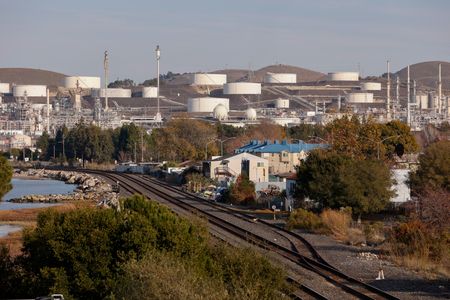By Laura Sanicola
(Reuters) – U.S. refining profits are expected to fall from last year’s records but remain strong as domestic refining outages and increased foreign competition pose challenges.
Refiners have come off a wave of favorable pricing and strong demand after pandemic-era plant closings and Russia’s invasion of Ukraine boosted margins. Slowing economic activity and an increase in global refining capacity has brought the market down from last year’s highs.
“Earnings will not be weak by any stretch, but should be more normal,” said TD Cowen analyst Jason Gabelman.
Oil production cuts from OPEC+ in the second quarter took heavy, sour barrels from the market that US refiners buy cheaply to make a higher profit off fuel sales.
A winter shortage of distillate fuels that allowed refiners to fetch a much higher price for jet fuel compared with diesel earlier in the year has also eased. Crude differentials and jet premiums to diesel are back near historical levels, Gabelman said.
Refiners such as Marathon and Phillips 66 also had problems with large fuel producing units in major facilities in Texas and New Jersey, preventing them from fully realizing potential profits.
Unplanned outages averaged near 550,000 bpd in June, 2023, compared to near 290,000 bpd in June 2022, according to data from refining intelligence firm IIR Energy.
Valero Energy, the second-largest U.S. refiner by capacity, kicks off earnings on Thursday with per share profit expected to fall by more than half at $5.07, based on the mean estimate of 17 analysts compiled by Refinitiv, compared to a whopping $11.36 per share a year ago.
Top U.S. refiner by volume Marathon Petroleum is forecast to show a per share profit of $4.60 compared to $10.61 a year ago, while Phillips 66 could deliver a $3.58 per share, compared to $6.77 a year ago, according to Refinitiv. Both are scheduled to report in early August.
Earlier this month, Exxon signaled that refining margins also reduced operating results at its gasoline and diesel business by $2.1 billion.
Going forward, refiners should benefit from a sustained, high crack spread – a proxy for refining margins – which is hovering around $37.50 per barrel, Refinitiv data showed.
But refiners could face challenges with new refining capacity coming online in Asia and the Middle East and weaker demand for diesel due to slowing in trucking and freight markets, Gabelman said.
“There’s not a lot of conviction in the outlook,” he added.
(Reporting by Laura Sanicola; Editing by Sharon Singleton)





